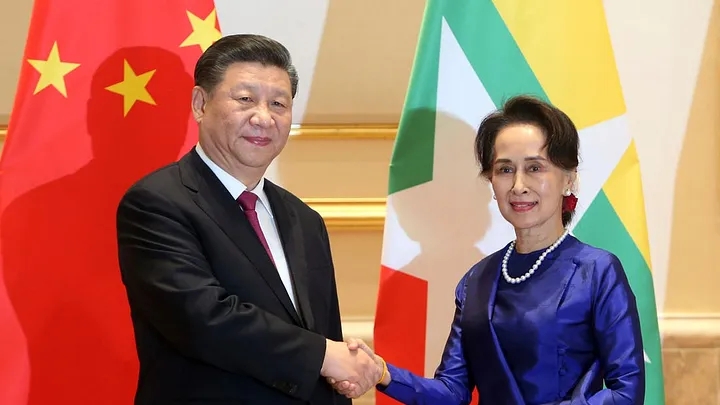
China Tightens Grip on Myanmar
Several years ago, the then Defence Minister George Fernandez predicted that China would go down via Pakistan in the west and Myanmar in the east in a pincer movement to suffocate India and to dominate South Asia. They have already built the Gwadar port in Pakistan and Hambantota in Sri Lanka to have access to the Indian Ocean and now they are building a third port in Myanmar to complete the encirclement of India. President Xi Jinping went to Myanmar to give final touches to his grand strategy to tighten his grip on Myanmar through his Belt and Road Initiative (BRI) to build railroads, highways, ports, and other infrastructure connecting China with other points in Asia, Europe, and Africa. He was on a billion dollar charm offensive in Myanmar.

Xi’s first visit abroad in 2020 to Myanmar is nominally on account of the 70th anniversary of the establishment of diplomatic relations between China and Myanmar, but he had a larger agenda of significantly boosting China's profile and future investments. The access to the Indian Ocean that the new port allows could permit its sizable oil and gas imports from the Persian Gulf to bypass going through the Strait of Malacca.
A Chinese President is visiting Myanmar after a twenty year gap
even though Myanmar has been an instrument of China’s political ambitions. Jiang Zemin was the last Chinese President to visit Myanmar, when he signed several economic and border agreements in 2001.
The timing of the visit of President XI is particularly important for Myanmar when it is under attack from the international community on the Rohingya issue and China acts as its protector from global criticism on human rights in Myanmar. None of the other permanent members of the UN Security Council supports Myanmar. Suu Kyi defended the military action by the Myanmar army at the International Court of Justice, further damaging her image. But before her trip to The Hague, she had met the Chinese Foreign Minister to show that she had powerful supporters. She came close to lose her Nobel Peace Prize on genocide charges. Interestingly, a 1.3 billion dollar deep sea port is being built in the Rakhine state from where 700,000 refugees fled for fear of death to Bangladesh and other Muslim countries.
Myanmar's general election is scheduled for late 2020 and Chinese support may brighten Suu Kyi’s electoral prospects. At the same time, too much of dancing with the dragon by wheeling and dealing with it could leave the government of the de facto leader, Aung San Suu Kyi, vulnerable to accusations by political opponents that it is selling out the country to China.
Internationally, Myanmar wants to show the Western world that China is backing them to escape harsher sanctions. Myanmar wanted to say to the West to be careful if they impose any sanctions. China also uses its influence with various Myanmar ethnic rebel groups based along the countries' border who are battling for autonomy from the central government. While China has promoted peace talks between the rebels and Myanmar's government, its close ties with some of the rebel groups allow it to retain the option of threatening violence by using ethnic guerrillas as proxies.
Another reason for the Chinese President’s visit was that there had been an undercurrent of anti-Chinese sentiment in Myanmar in response to some heavy-handed implementation of Chinese-backed projects that run roughshod over local communities, provoking allegations of land-grabbing, environmental damage, and selling out the country's resources. Myanmar's previous military-backed government was forced by popular demand to suspend plans for the massive $3.6 billion Myitsone hydroelectric dam project in 2011, but it has not been cancelled even though there are serious concerns about environmental damage if the dam is built.
Xi's visit led to giving the go-ahead to another project more important to Beijing, the Kyaukphyu Special Economic Zone on the Bay of Bengal. With a deep-water port, it is the terminus of the 1,055-mile-long China-Myanmar Economic Corridor, a major link in the Belt and Road Initiative whose other end is in China's Yunnan province. It includes cross-border oil and gas pipelines that have been operating for years. An industrial park and major railway are planned, though projected high costs have been a disincentive. Amnesty International, which has been a harsh critic of Chinese involvement in Myanmar has expressed concern over these projects.
At a particularly vulnerable time for the Myanmar regime in the face of international isolation and falling western investments, China has given it a morale boost by the President’s visit. The two sides exchanged memoranda of understanding, letters and protocols covering 33 projects in the fields of infrastructure, information, industry, agriculture, security and the resettlement of internally displaced people in Myanmar's war-torn Kachin State, which borders China.
India’s own investments, particularly in the energy sector have paled into insignificance against the massive investment plan that Xi has unveiled. India was the first to express solidarity to Myanmar on the Rohingya issue, but India came under pressure to take a more balanced view on account of objections by Bangladesh and the international community. India has adopted a strategy of support to Bangladesh to handle the refugees, assistance to development in Rakhine state and not expelling Rohingya settlers in India. With no such qualms, China has won over Myanmar by extending political support and economic assistance posing a direct challenge to India in the region.
~~~~~~~~~~~~~~~~~~~~~~~~~~~~~~~~~~~~~~~~~~~~~~~~~~~~~~~~~
The facts and views expressed in the article are those of the writer.
